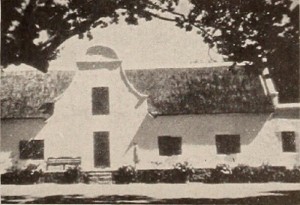
"The solid splendor of Dutch colonial existence in South Africa is attractively recreated in White Gables, by G. Brian McIntosh. Moving out from Capetown, the film carries one swiftly over the barrier crags of Table Mountain into the fertile valley beyond. Here, surrounded by its flowers and fields of grape, stands Groot Constantia, the great and graceful manor house built by Governor Simon van der Stel in 1685. Mr. Mcintosh presents it with sympathy, imagination and skill. Scene flows into scene, sequence into sequence, with a suave progression which could have been achieved only by the most cunning advanced plan. A gracious lady in 17th Century dress moves through the terraced grounds on the gentle errands of that leisured age. White Gables is a bright and glowing evocation of mood and manner which now are history." Movie Makers, Dec. 1946, 489.
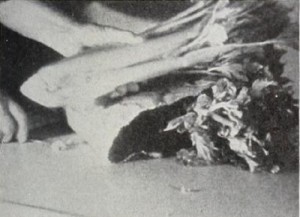
"White Hearts, filmed by William R. Hutchinson, whose Blossom Forth the Fruit placed in Ten Best last year, presents further evidence of Mr. Hutchinson's understanding of the treatment necessary in handling progressive developments in nature when it is used for educational subjects. This story of celery raising begins with shots of farmers preparing the rich black soil and concludes with sequences showing the produce, packaged, ready for shipment. One of the difficulties overcome was the achievement of variety of value in the scenes showing the white celery stalks in contrast with extremely dark earth. Human interest is introduced by including intimate shots of the workers. Logical progression, interesting compositional effects and a genuine feeling for texture and tactile values make this a fine study picture." Movie Makers, Dec. 1942, 508.
"Myron F. Pettengill was awarded the trophy for Scenario pictures. This is a 16mm film of about 400 ft. It is a story of the Northwest Mounted. Pettingill is to be commended for his direction, his types, and the way in which he costumed his people. He injected little touches in his characters that left no doubt as to what they represented. He costumed them convincingly. It had many indoor scenes and of course a large amount of outdoor snow scenes. There was a fine handling of the camera." American Cinematographer, Jan. 1937, 25.
"a dialogue story written specially to suit synchronised disc recording" (HMHT 1933: 197).
"Whither Flowing," depicts the nervous evils caused by parents in the thoughtless upbringing of children. The drama was compactly told, well acted and directed, and was marked by unusual photography." Photoplay, Nov. 1929, 67. "...Whither Flowing is a psychological study of hysteria.... Dr. Heise's Whither Flowing won second award in the dramatic division of the recent Photoplay Magazine contest...” Movie Makers, Feb. 1930, 104.
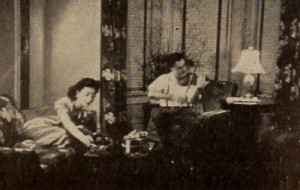
"Using black and white film, Carl D. Frazier has produced a tightly knit and well paced farce of a married couple and a burglar. Excellent lighting of wholly interior settings shows study of the monochrome medium and, properly exploited, how it can result in sparkling results. The acting is adequate for the simple plot, but it is the camera work and editing that make the film above average." Movie Makers, Dec. 1949, 472.
"Who's Been Sleeping in My Bed Now, you see, there was this turtle, and he wanted to go home with me and spend the night. Well, that was all right with me, so I took this turtle home and he even slept right in my bed. You don't believe my story? Well, neither does my wife! But it is all told in this film, right down to the bare facts in the end!" PSA Journal, Aug. 1967, 37.
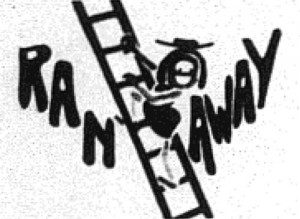
"Who's Got the Bucket? is a color cartoon that is funny enough to win the Humorous Award. This year's 3-minute entry by John Guirk of Brooklyn is so different in its art technique that it could almost be classified as an experimental or an abstract film. It's fast moving and holds audience interest to the very end" PSA Journal, Nov. 1969, 56.
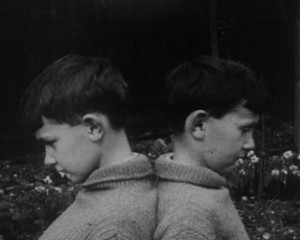
"Amateur filmmaker, cinema historian and railway engineer H.A.V. Bulleid presents a comedy of manners featuring a mysterious arrival from a distant land. A family endure a group photograph, taken by their maid, but are interrupted by the arrival of a letter announcing the imminent visit of an Australian cousin named Kit, and his companion, named only as 'Pilkington'. The daughter speculates over the identity of Pilkington, hoping for a notorious Australian bushranger, but Cousin Kit arrives accompanied only by a large cardboard box. Inside is the answer to all their questions - a dog - the very same Mr. Pilkington. But will Kit and Pilkington upset the normal balance of the family? Or will the family only upset their Antipodean cousins? And will Kit achieve his aim of finding an English wife?" (EAFA Database)
Total Pages: 299